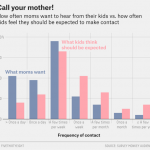This weekend, I’m going up to NYC to see my family, and we’re all seeing the B’way production of Newsies!
I certainly hope you’re all familiar with the best Disney musical, which is based on the Newsboys Strike of 1899, so perhaps you’d all like to pause and sing along with me and a very young Christian Bale:
The NYT did a nice piece about the genesis of the musical and it’s relation to the source material. The best revelation? Most of the characters names in the show (Crutchy Morris, Racetrack Higgins, Spot Conlon) were the real names of the strikers.

So in their honor, it’s an all news-themed Quick Takes.
It’s no match for scrappy youngsters wearing vests, but I really like this video made by The Guardian to highlight the way reporting doesn’t just convey the news, it makes the news.
And now, to highlight some excellent journalism. Foreign Policy recently had a great piece on Patrick Ball — a statistician who analyzes human migrations and testifies in genocide trials.
Since the 1984 publication of Nunca Más, the report of Argentina’s National Commission on the Disappearance of Persons — the first modern truth commission — information about the toll of war and political repression has been routinely collected on a massive scale. Truth commissions from Chile to East Timor have gathered testimonies from tens of thousands of people, a process designed to provide dignity to the victims, identify crimes that require justice or restitution, and write the story of what happened — to try, as much as possible, to give closure to the past. Today, technology has speeded up and broadened the reporting process: Crowdsourced mapping tools collect and plot thousands of text messages from people who have witnessed violence. Ordinary people with cell phones take pictures and videos of atrocities that are uploaded and seen around the world.
But possessing an ocean of testimony is not the same as knowing the truth. No matter how many cases we learn of, they might not be representative of the whole. A truth commission might be scorned by a particular linguistic or ethnic group, which means its members don’t come forward to speak. Fewer media reports of killings might actually mean fewer killings — or it could mean that journalists were intimidated into silence. Human rights groups might record a decline in violence because budget cuts forced them to fire half their outreach team. Rape might never be disclosed. Video collected by cell phones tells us only what was witnessed by people with cell phones.
It’s statistical methods that help you figure out if your data is skewed and how you can compensate for it. Ball’s research has undergirded many human rights stories, and I’m so pleased that FP singled it out for coverage in its own right.
And speaking of statistics, here’s a fun exercise: can you see any problems with the graph below?

Mike Flynn does a thorough take-down at this blog, but the gist that you should be very suspicious when someone shows you a linear relation that seems to mostly be shaped by a group of anomalous data points (the data circa 2008).
To add to Flynn’s critique: you want to be especially careful with this kind of graph when you’re plotting your data against a time-series. For a lot of other independent variables, you might reasonably expect their relation to the variable you’re studying is continuous — i.e. that small changes in your independent variable (for example: number of students per class) result in small changes in your dependent variable (amount of time that the teacher spends individually with each student).
But when you’re looking at time-series data, the passing of time is really confounded with a lot of other factors (economic conditions, wars, new scientific discoveries, etc) which can change suddenly. So a small change in time can correspond to a big shift in the variables that are actually shaping your outcome, and it may be unreasonable to expect a linear relationship in the first place.
Note: the above was totally still relevant to the stated theme of news because data drives news! And if journalists can’t spot bad statistics, their reporting will be flawed! And unworthy of being featured in these themed Takes!

Luckily, some journalists are also major wonks, and one of my favorites in that genre is Ezra Klein of the Washington Post. He recently wrote a good book review/meditation on the role of money in politics for The New York Review of Books. Here’s a preview:
In other words, lobbyists act like a volunteer, and highly skilled, army for politicians who already agree with them.
This is the most benign, generous explanation of lobbying, but it does not render the practice innocent. In this model, the point of lobbyists is not so much to change votes as to change the legislative agenda. Perhaps you are a legislator interested both in reforming the nation’s drug laws and in cutting taxes on large corporations. If you focus your time on tax cuts for large corporations, you’ll get an enormous amount of money, aid, and attention from lobbyists. If you spend your time on drug policy, you’ll be ignored and your campaign will be underfunded. The disparity is even greater on smaller issues where there may not be another side to engage the debate: if a group of paper companies spends a couple of million dollars hiring lobbyists to persuade politicians of the merits of a change to an obscure provision of the tax code that will net the paper companies a couple of billion dollars, there is likely no one on the other side of that issue amassing materials to explain why this change isn’t a good idea.
And if you’d like to make a satorial statement in support of newspapers, perhaps you’ll like this tutorial for a newsprint manicure:
Finally, just a reminder that you can vote once per day for the About.com Atheism Awards. I’m one of five nominees for Best Atheist Blog. More details here.
For more Quick Takes, visit Conversion Diary!













